EX-99.1
Published on November 5, 2015

The PNC Financial Services Group, Inc. BancAnalysts Association of Boston Conference November 5, 2015 Exhibit 99.1
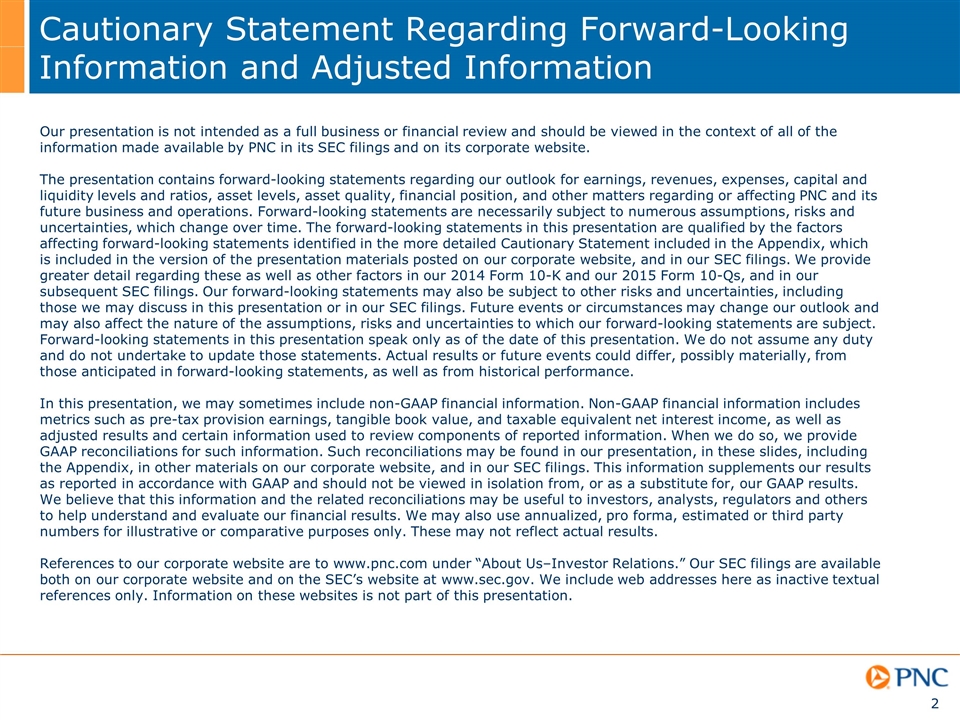
Cautionary Statement Regarding Forward-Looking Information and Adjusted Information Our presentation is not intended as a full business or financial review and should be viewed in the context of all of the information made available by PNC in its SEC filings and on its corporate website. The presentation contains forward-looking statements regarding our outlook for earnings, revenues, expenses, capital and liquidity levels and ratios, asset levels, asset quality, financial position, and other matters regarding or affecting PNC and its future business and operations. Forward-looking statements are necessarily subject to numerous assumptions, risks and uncertainties, which change over time. The forward-looking statements in this presentation are qualified by the factors affecting forward-looking statements identified in the more detailed Cautionary Statement included in the Appendix, which is included in the version of the presentation materials posted on our corporate website, and in our SEC filings. We provide greater detail regarding these as well as other factors in our 2014 Form 10-K and our 2015 Form 10-Qs, and in our subsequent SEC filings. Our forward-looking statements may also be subject to other risks and uncertainties, including those we may discuss in this presentation or in our SEC filings. Future events or circumstances may change our outlook and may also affect the nature of the assumptions, risks and uncertainties to which our forward-looking statements are subject. Forward-looking statements in this presentation speak only as of the date of this presentation. We do not assume any duty and do not undertake to update those statements. Actual results or future events could differ, possibly materially, from those anticipated in forward-looking statements, as well as from historical performance. In this presentation, we may sometimes include non-GAAP financial information. Non-GAAP financial information includes metrics such as pre-tax provision earnings, tangible book value, and taxable equivalent net interest income, as well as adjusted results and certain information used to review components of reported information. When we do so, we provide GAAP reconciliations for such information. Such reconciliations may be found in our presentation, in these slides, including the Appendix, in other materials on our corporate website, and in our SEC filings. This information supplements our results as reported in accordance with GAAP and should not be viewed in isolation from, or as a substitute for, our GAAP results. We believe that this information and the related reconciliations may be useful to investors, analysts, regulators and others to help understand and evaluate our financial results. We may also use annualized, pro forma, estimated or third party numbers for illustrative or comparative purposes only. These may not reflect actual results. References to our corporate website are to www.pnc.com under “About Us–Investor Relations.” Our SEC filings are available both on our corporate website and on the SEC’s website at www.sec.gov. We include web addresses here as inactive textual references only. Information on these websites is not part of this presentation.

Agenda Our business model Continued focus on achieving our capital objectives and expense management Our strategic priorities provide levers in a low rate environment
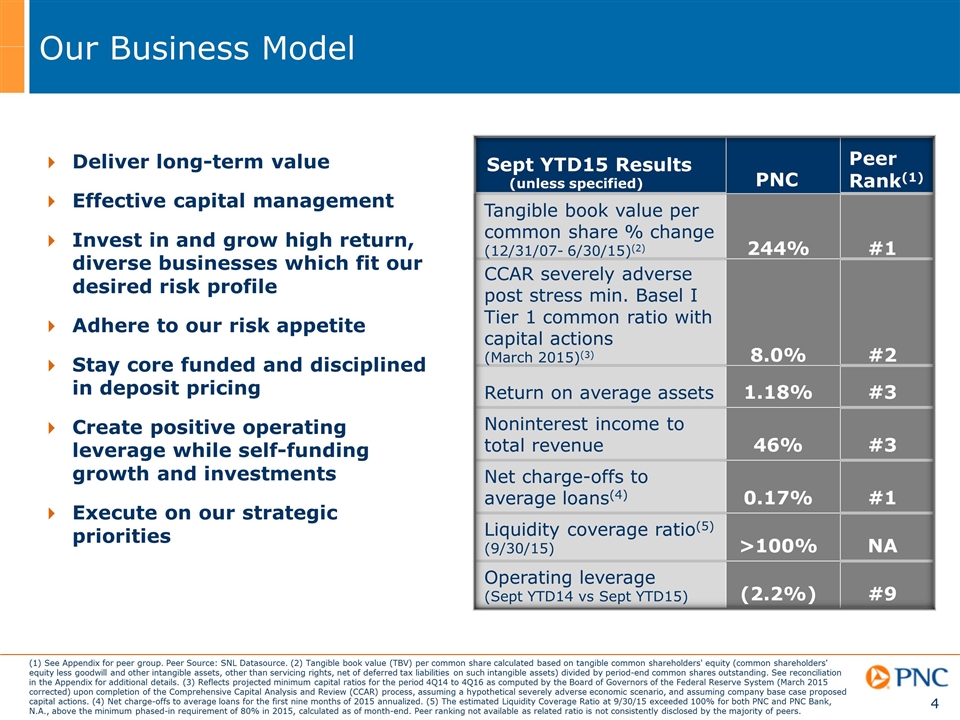
Our Business Model Deliver long-term value Effective capital management Invest in and grow high return, diverse businesses which fit our desired risk profile Adhere to our risk appetite Stay core funded and disciplined in deposit pricing Create positive operating leverage while self-funding growth and investments Execute on our strategic priorities Tangible book value per common share % change (12/31/07- 6/30/15)(2) 244% #1 CCAR severely adverse post stress min. Basel I Tier 1 common ratio with capital actions (March 2015)(3) 8.0% #2 Return on average assets 1.18% #3 Noninterest income to total revenue 46% #3 Net charge-offs to average loans(4) 0.17% #1 Liquidity coverage ratio(5) (9/30/15) >100% NA Operating leverage (Sept YTD14 vs Sept YTD15) (2.2%) #9 Sept YTD15 Results (unless specified) PNC Peer Rank(1) (1) See Appendix for peer group. Peer Source: SNL Datasource. (2) Tangible book value (TBV) per common share calculated based on tangible common shareholders' equity (common shareholders' equity less goodwill and other intangible assets, other than servicing rights, net of deferred tax liabilities on such intangible assets) divided by period-end common shares outstanding. See reconciliation in the Appendix for additional details. (3) Reflects projected minimum capital ratios for the period 4Q14 to 4Q16 as computed by the Board of Governors of the Federal Reserve System (March 2015 corrected) upon completion of the Comprehensive Capital Analysis and Review (CCAR) process, assuming a hypothetical severely adverse economic scenario, and assuming company base case proposed capital actions. (4) Net charge-offs to average loans for the first nine months of 2015 annualized. (5) The estimated Liquidity Coverage Ratio at 9/30/15 exceeded 100% for both PNC and PNC Bank, N.A., above the minimum phased-in requirement of 80% in 2015, calculated as of month-end. Peer ranking not available as related ratio is not consistently disclosed by the majority of peers.
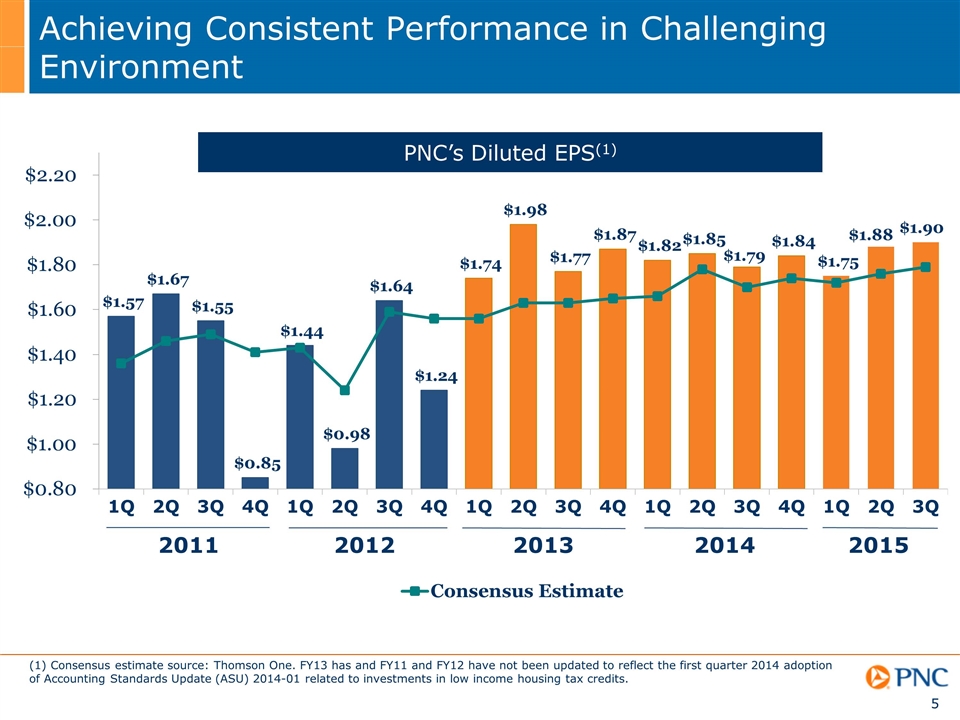
Achieving Consistent Performance in Challenging Environment 2013 2014 2012 2011 2015 PNC’s Diluted EPS(1) (1) Consensus estimate source: Thomson One. FY13 has and FY11 and FY12 have not been updated to reflect the first quarter 2014 adoption of Accounting Standards Update (ASU) 2014-01 related to investments in low income housing tax credits.

Balance Sheet Remains Liquid Total Loan Growth Interest-Earning Assets Growth Interest-Earning Deposits With Banks 2X Growth $ in billions Total Deposit Growth 5X Growth (1) Percentages calculated by comparing nine month average balances to prior year nine month average balances. Average Balances(1)
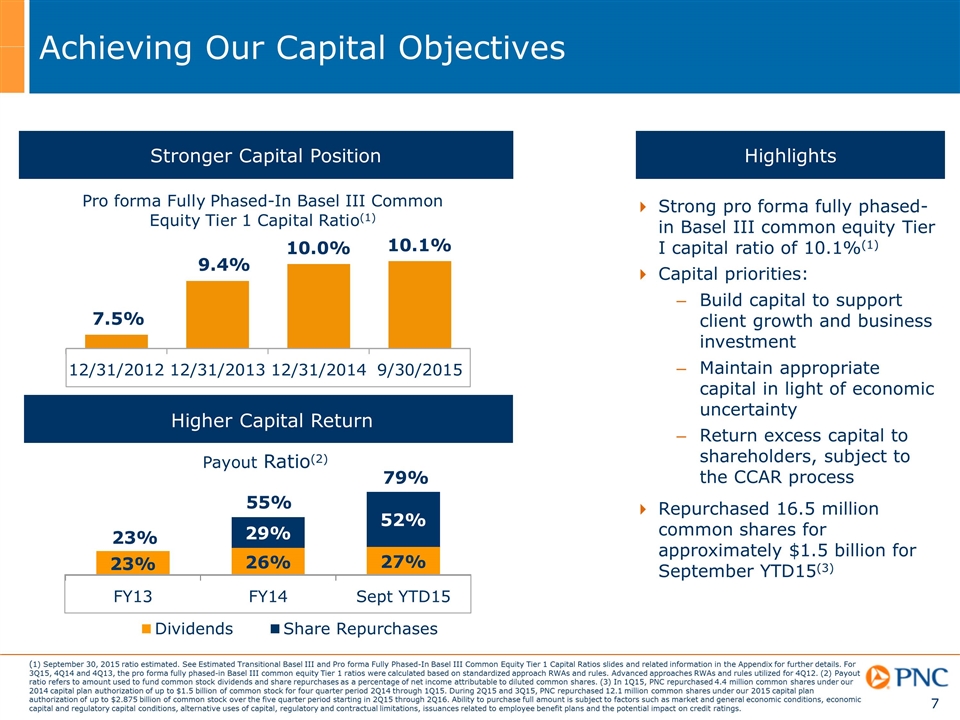
Achieving Our Capital Objectives Higher Capital Return Highlights Strong pro forma fully phased-in Basel III common equity Tier I capital ratio of 10.1%(1) Capital priorities: Build capital to support client growth and business investment Maintain appropriate capital in light of economic uncertainty Return excess capital to shareholders, subject to the CCAR process Repurchased 16.5 million common shares for approximately $1.5 billion for September YTD15(3) (1) September 30, 2015 ratio estimated. See Estimated Transitional Basel III and Pro forma Fully Phased-In Basel III Common Equity Tier 1 Capital Ratios slides and related information in the Appendix for further details. For 3Q15, 4Q14 and 4Q13, the pro forma fully phased-in Basel III common equity Tier 1 ratios were calculated based on standardized approach RWAs and rules. Advanced approaches RWAs and rules utilized for 4Q12. (2) Payout ratio refers to amount used to fund common stock dividends and share repurchases as a percentage of net income attributable to diluted common shares. (3) In 1Q15, PNC repurchased 4.4 million common shares under our 2014 capital plan authorization of up to $1.5 billion of common stock for four quarter period 2Q14 through 1Q15. During 2Q15 and 3Q15, PNC repurchased 12.1 million common shares under our 2015 capital plan authorization of up to $2.875 billion of common stock over the five quarter period starting in 2Q15 through 2Q16. Ability to purchase full amount is subject to factors such as market and general economic conditions, economic capital and regulatory capital conditions, alternative uses of capital, regulatory and contractual limitations, issuances related to employee benefit plans and the potential impact on credit ratings. Payout Ratio(2) 79% 55% Stronger Capital Position 23%
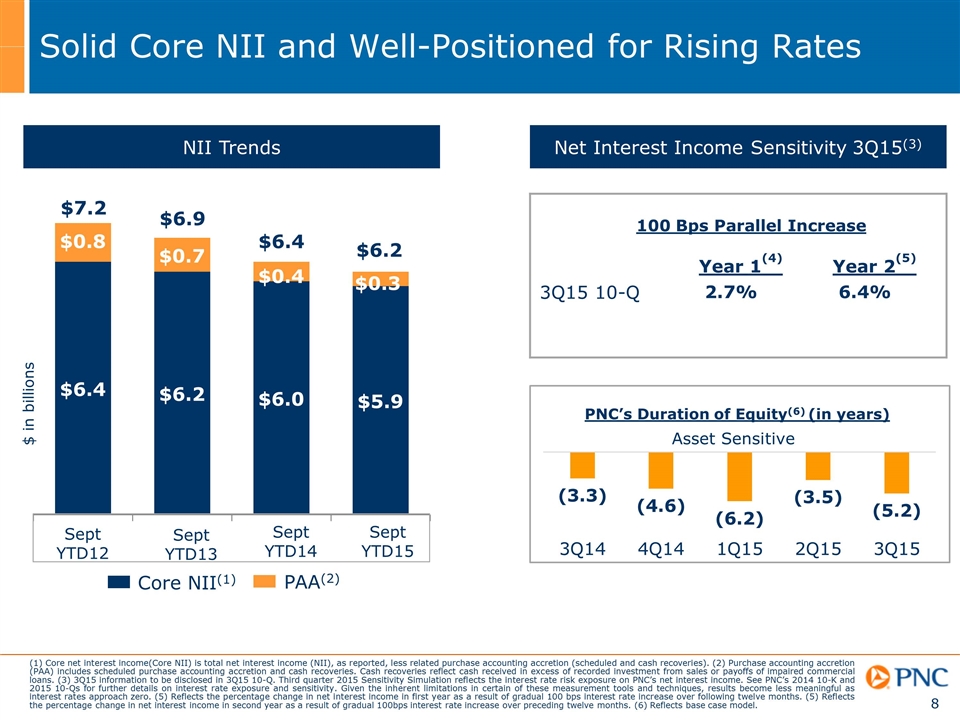
Sept YTD12 Sept YTD13 Sept YTD14 Sept YTD15 Solid Core NII and Well-Positioned for Rising Rates NII Trends $ in billions $7.2 Core NII(1) PAA(2) (1) Core net interest income(Core NII) is total net interest income (NII), as reported, less related purchase accounting accretion (scheduled and cash recoveries). (2) Purchase accounting accretion (PAA) includes scheduled purchase accounting accretion and cash recoveries. Cash recoveries reflect cash received in excess of recorded investment from sales or payoffs of impaired commercial loans. (3) 3Q15 information to be disclosed in 3Q15 10-Q. Third quarter 2015 Sensitivity Simulation reflects the interest rate risk exposure on PNC’s net interest income. See PNC’s 2014 10-K and 2015 10-Qs for further details on interest rate exposure and sensitivity. Given the inherent limitations in certain of these measurement tools and techniques, results become less meaningful as interest rates approach zero. (5) Reflects the percentage change in net interest income in first year as a result of gradual 100 bps interest rate increase over following twelve months. (5) Reflects the percentage change in net interest income in second year as a result of gradual 100bps interest rate increase over preceding twelve months. (6) Reflects base case model. $6.4 $6.9 $6.2 Year 1(4) Year 2(5) 3Q15 10-Q 2.7% 6.4% Net Interest Income Sensitivity 3Q15(3) 100 Bps Parallel Increase Asset Sensitive
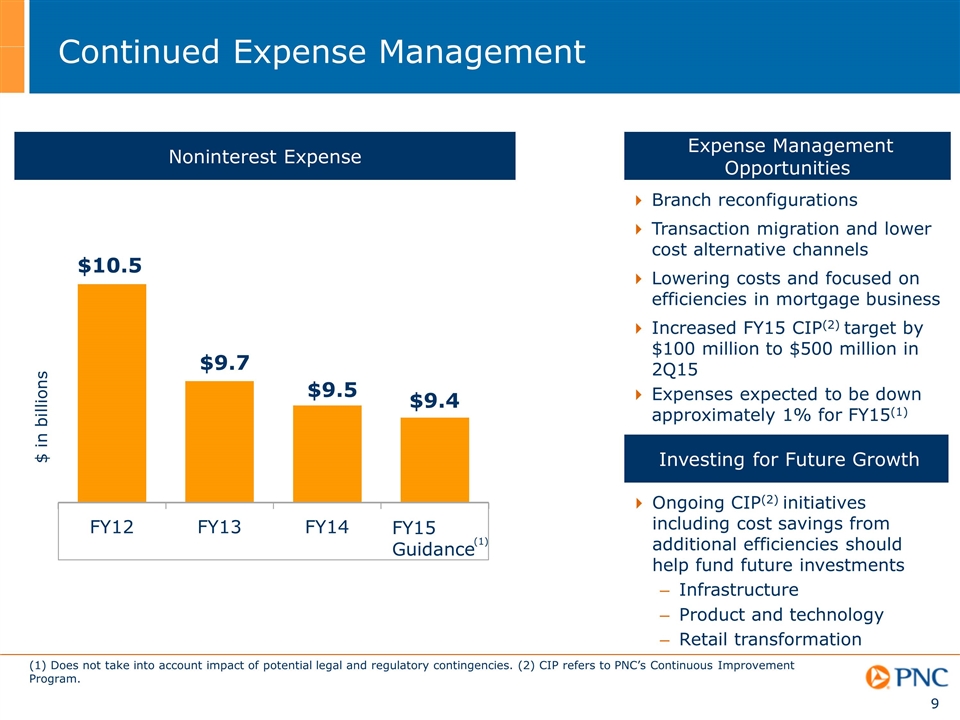
Branch reconfigurations Transaction migration and lower cost alternative channels Lowering costs and focused on efficiencies in mortgage business Increased FY15 CIP(2) target by $100 million to $500 million in 2Q15 Expenses expected to be down approximately 1% for FY15(1) Ongoing CIP(2) initiatives including cost savings from additional efficiencies should help fund future investments Infrastructure Product and technology Retail transformation Continued Expense Management Noninterest Expense Expense Management Opportunities (1) Does not take into account impact of potential legal and regulatory contingencies. (2) CIP refers to PNC’s Continuous Improvement Program. Investing for Future Growth $ in billions (1) FY15 Guidance
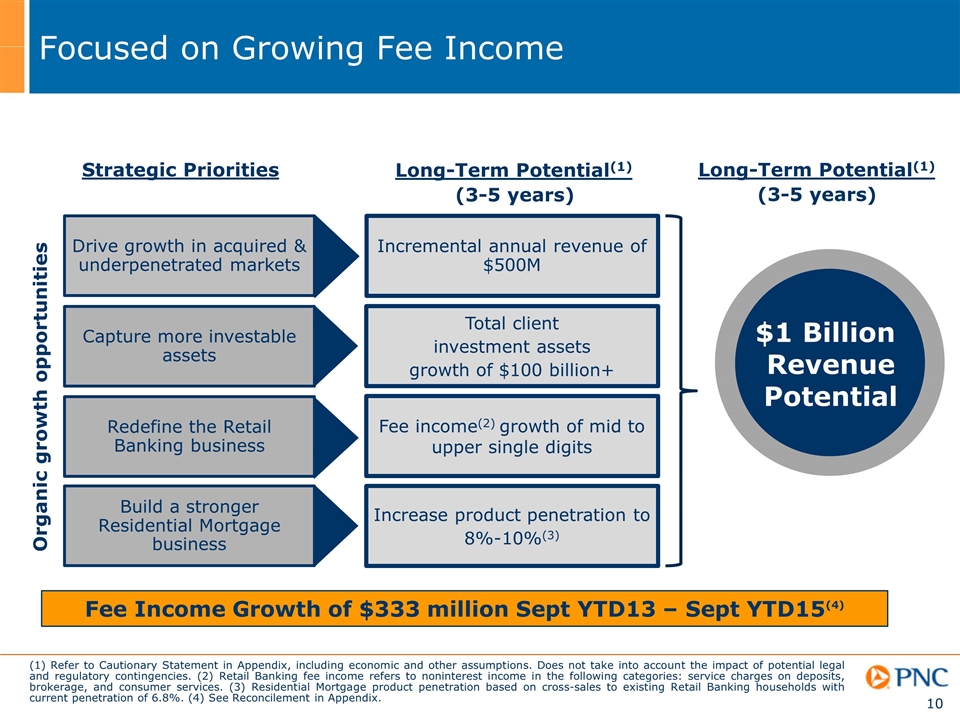
Focused on Growing Fee Income Strategic Priorities Organic growth opportunities Long-Term Potential(1) Incremental annual revenue of $500M Total client investment assets growth of $100 billion+ Fee income(2) growth of mid to upper single digits Increase product penetration to 8%-10%(3) Drive growth in acquired & underpenetrated markets Capture more investable assets Redefine the Retail Banking business Build a stronger Residential Mortgage business (1) Refer to Cautionary Statement in Appendix, including economic and other assumptions. Does not take into account the impact of potential legal and regulatory contingencies. (2) Retail Banking fee income refers to noninterest income in the following categories: service charges on deposits, brokerage, and consumer services. (3) Residential Mortgage product penetration based on cross-sales to existing Retail Banking households with current penetration of 6.8%. (4) See Reconcilement in Appendix. Long-Term Potential(1) (3-5 years) (3-5 years) $1 Billion Revenue Potential Fee Income Growth of $333 million Sept YTD13 – Sept YTD15(4)
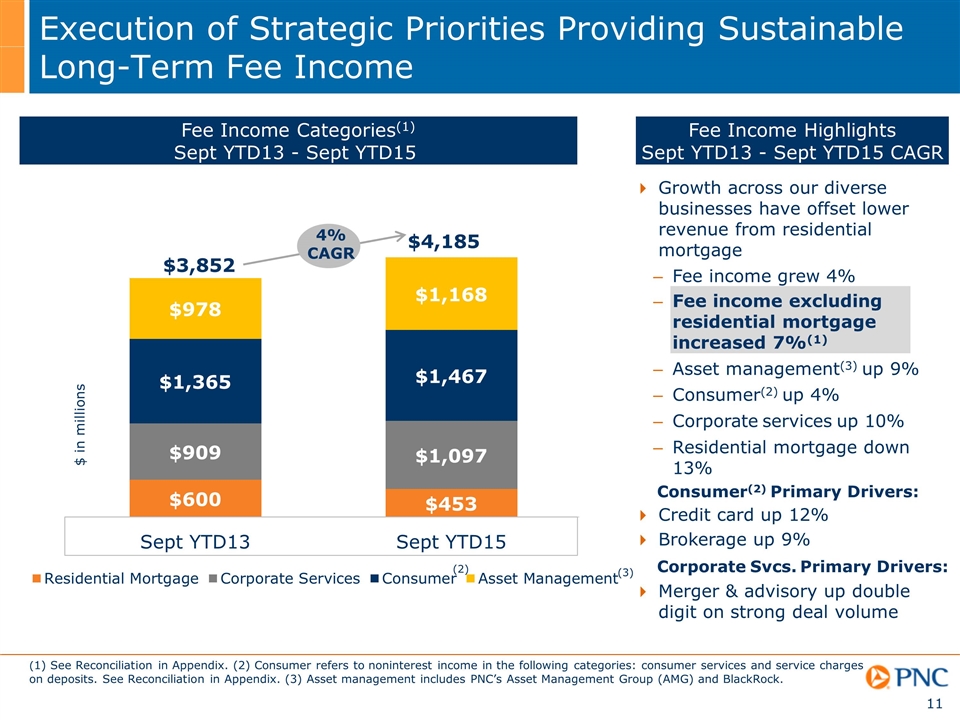
Growth across our diverse businesses have offset lower revenue from residential mortgage Fee income grew 4% Fee income excluding residential mortgage increased 7%(1) Asset management(3) up 9% Consumer(2) up 4% Corporate services up 10% Residential mortgage down 13% Execution of Strategic Priorities Providing Sustainable Long-Term Fee Income Fee Income Categories(1) Sept YTD13 - Sept YTD15 Fee Income Highlights Sept YTD13 - Sept YTD15 CAGR $4,185 Credit card up 12% Brokerage up 9% Merger & advisory up double digit on strong deal volume Corporate Svcs. Primary Drivers: (1) See Reconciliation in Appendix. (2) Consumer refers to noninterest income in the following categories: consumer services and service charges on deposits. See Reconciliation in Appendix. (3) Asset management includes PNC’s Asset Management Group (AMG) and BlackRock. (2) $ in millions $3,852 4% CAGR Consumer(2) Primary Drivers: (3)
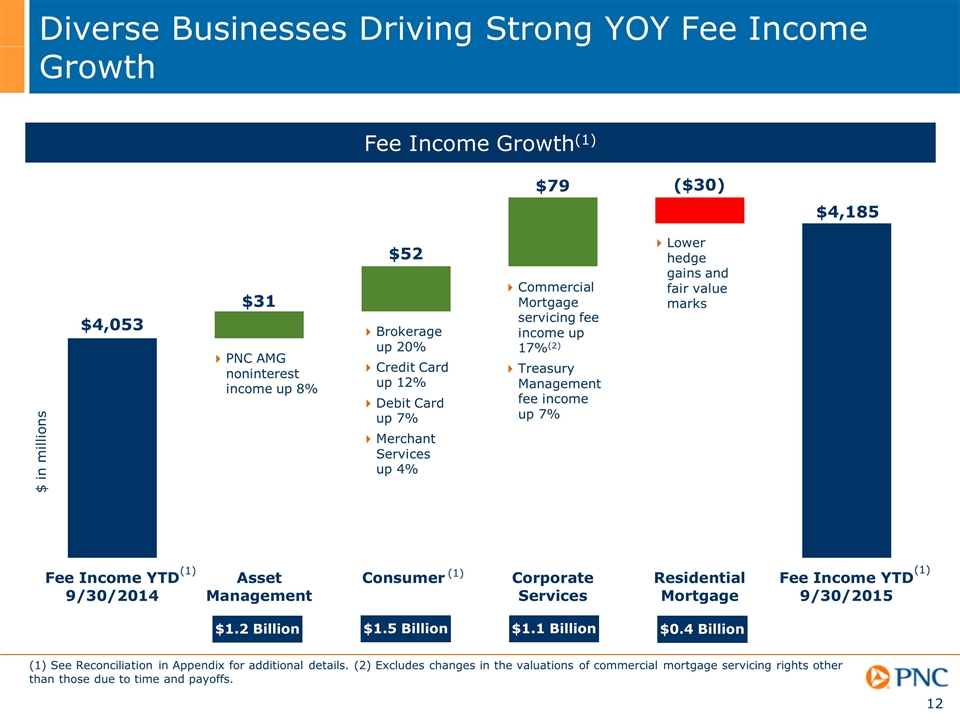
Diverse Businesses Driving Strong YOY Fee Income Growth Fee Income Growth(1) Brokerage up 20% Credit Card up 12% Debit Card up 7% Merchant Services up 4% PNC AMG noninterest income up 8% Commercial Mortgage servicing fee income up 17%(2) Treasury Management fee income up 7% Lower hedge gains and fair value marks $1.2 Billion $1.5 Billion $1.1 Billion $0.4 Billion $ in millions (1) See Reconciliation in Appendix for additional details. (2) Excludes changes in the valuations of commercial mortgage servicing rights other than those due to time and payoffs. (1) (1) (1)
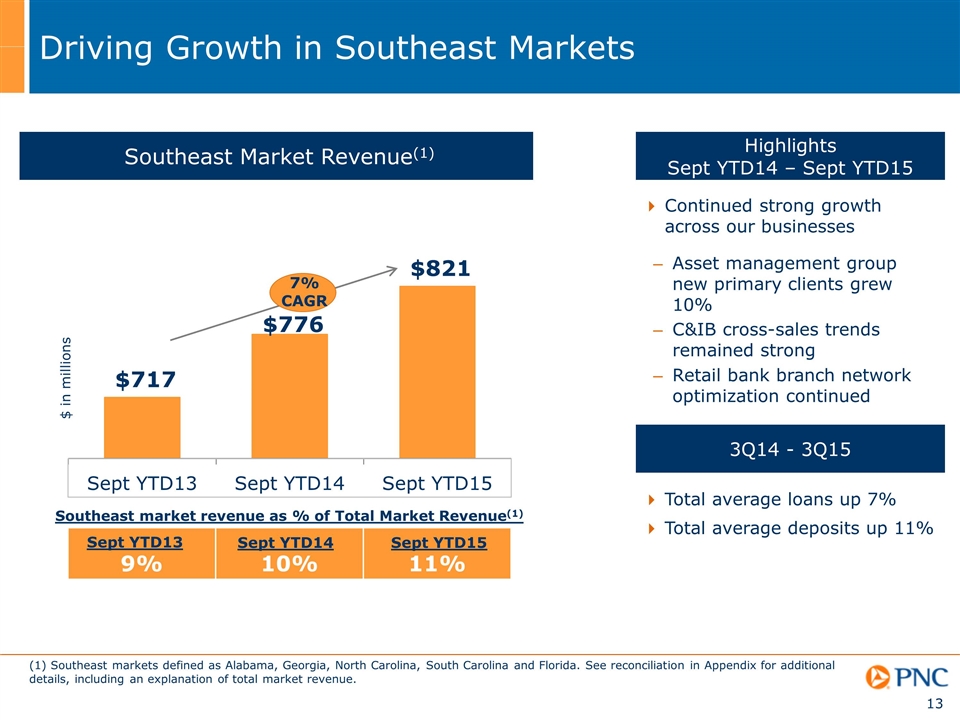
Driving Growth in Southeast Markets Southeast Market Revenue(1) (1) Southeast markets defined as Alabama, Georgia, North Carolina, South Carolina and Florida. See reconciliation in Appendix for additional details, including an explanation of total market revenue. 9% 10% 11% $ in millions Southeast market revenue as % of Total Market Revenue(1) 7% CAGR Highlights Sept YTD14 – Sept YTD15 Continued strong growth across our businesses Asset management group new primary clients grew 10% C&IB cross-sales trends remained strong Retail bank branch network optimization continued Total average loans up 7% Total average deposits up 11% 3Q14 - 3Q15 Sept YTD13 Sept YTD14 Sept YTD15
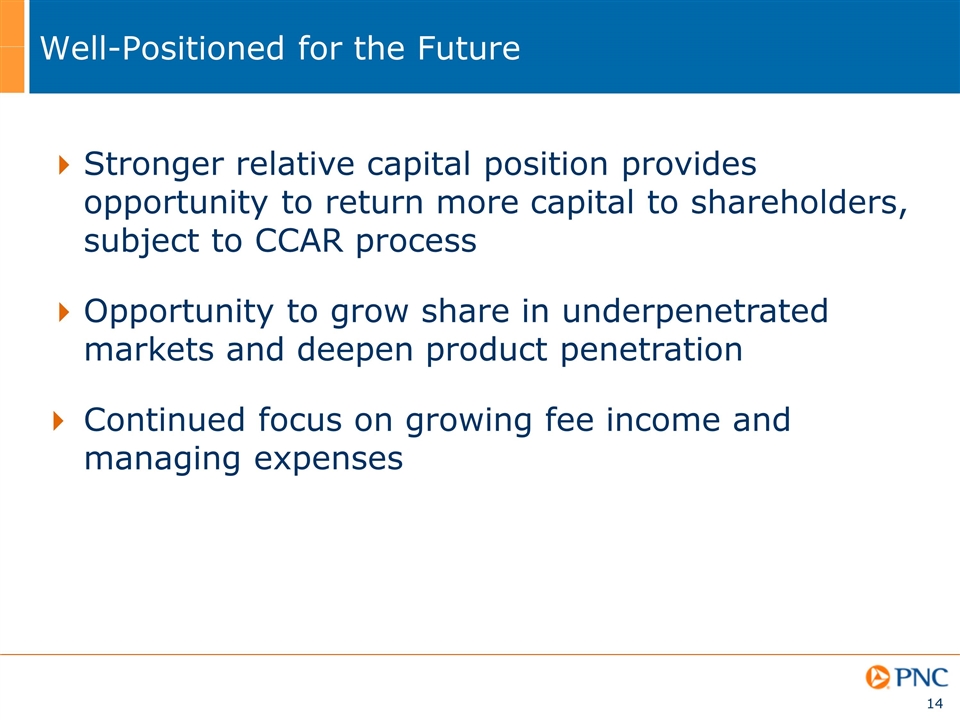
Well-Positioned for the Future Stronger relative capital position provides opportunity to return more capital to shareholders, subject to CCAR process Opportunity to grow share in underpenetrated markets and deepen product penetration Continued focus on growing fee income and managing expenses
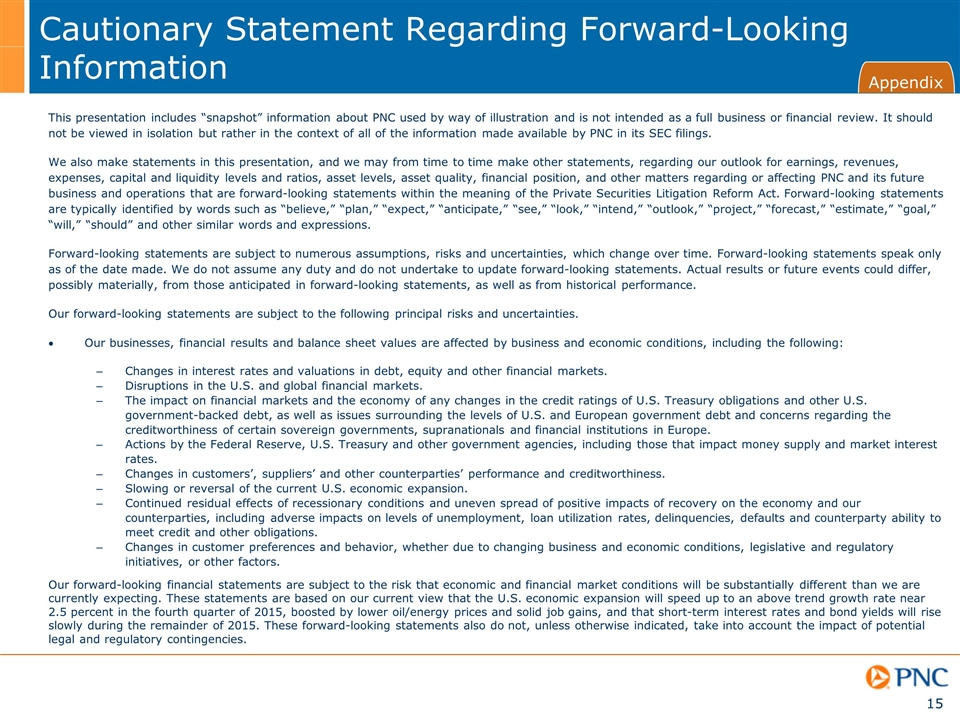
Cautionary Statement Regarding Forward-Looking Information Appendix This presentation includes “snapshot” information about PNC used by way of illustration and is not intended as a full business or financial review. It should not be viewed in isolation but rather in the context of all of the information made available by PNC in its SEC filings. We also make statements in this presentation, and we may from time to time make other statements, regarding our outlook for earnings, revenues, expenses, capital and liquidity levels and ratios, asset levels, asset quality, financial position, and other matters regarding or affecting PNC and its future business and operations that are forward-looking statements within the meaning of the Private Securities Litigation Reform Act. Forward-looking statements are typically identified by words such as “believe,” “plan,” “expect,” “anticipate,” “see,” “look,” “intend,” “outlook,” “project,” “forecast,” “estimate,” “goal,” “will,” “should” and other similar words and expressions. Forward-looking statements are subject to numerous assumptions, risks and uncertainties, which change over time. Forward-looking statements speak only as of the date made. We do not assume any duty and do not undertake to update forward-looking statements. Actual results or future events could differ, possibly materially, from those anticipated in forward-looking statements, as well as from historical performance. Our forward-looking statements are subject to the following principal risks and uncertainties. Our businesses, financial results and balance sheet values are affected by business and economic conditions, including the following: Changes in interest rates and valuations in debt, equity and other financial markets. Disruptions in the U.S. and global financial markets. The impact on financial markets and the economy of any changes in the credit ratings of U.S. Treasury obligations and other U.S. government-backed debt, as well as issues surrounding the levels of U.S. and European government debt and concerns regarding the creditworthiness of certain sovereign governments, supranationals and financial institutions in Europe. Actions by the Federal Reserve, U.S. Treasury and other government agencies, including those that impact money supply and market interest rates. Changes in customers’, suppliers’ and other counterparties’ performance and creditworthiness. Slowing or reversal of the current U.S. economic expansion. Continued residual effects of recessionary conditions and uneven spread of positive impacts of recovery on the economy and our counterparties, including adverse impacts on levels of unemployment, loan utilization rates, delinquencies, defaults and counterparty ability to meet credit and other obligations. Changes in customer preferences and behavior, whether due to changing business and economic conditions, legislative and regulatory initiatives, or other factors. Our forward-looking financial statements are subject to the risk that economic and financial market conditions will be substantially different than we are currently expecting. These statements are based on our current view that the U.S. economic expansion will speed up to an above trend growth rate near 2.5 percent in the fourth quarter of 2015, boosted by lower oil/energy prices and solid job gains, and that short-term interest rates and bond yields will rise slowly during the remainder of 2015. These forward-looking statements also do not, unless otherwise indicated, take into account the impact of potential legal and regulatory contingencies.
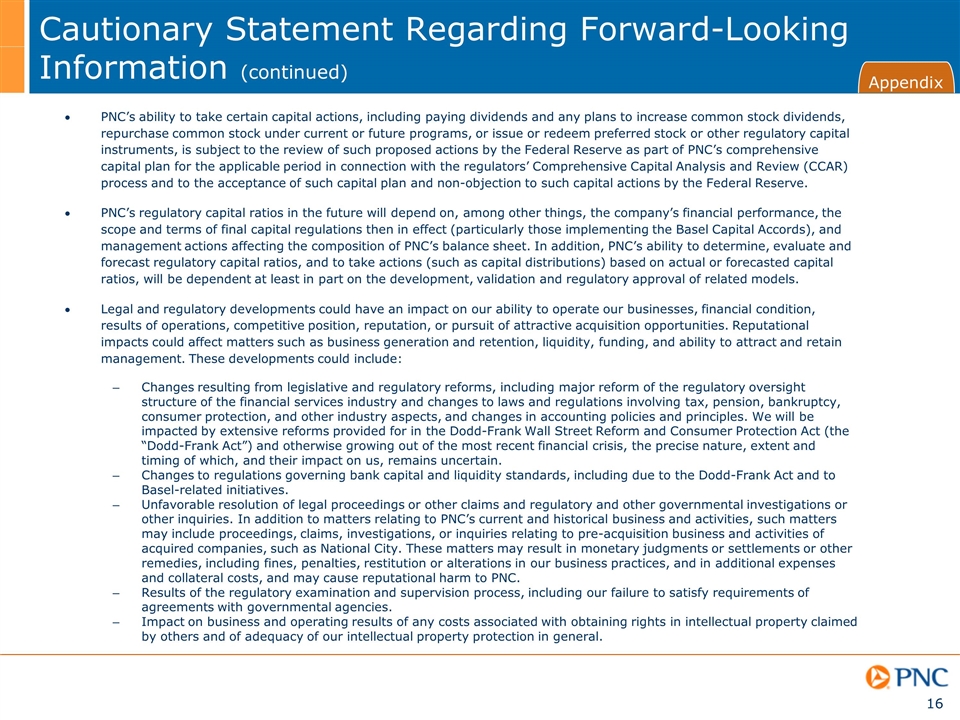
Cautionary Statement Regarding Forward-Looking Information (continued) Appendix PNC’s ability to take certain capital actions, including paying dividends and any plans to increase common stock dividends, repurchase common stock under current or future programs, or issue or redeem preferred stock or other regulatory capital instruments, is subject to the review of such proposed actions by the Federal Reserve as part of PNC’s comprehensive capital plan for the applicable period in connection with the regulators’ Comprehensive Capital Analysis and Review (CCAR) process and to the acceptance of such capital plan and non-objection to such capital actions by the Federal Reserve. PNC’s regulatory capital ratios in the future will depend on, among other things, the company’s financial performance, the scope and terms of final capital regulations then in effect (particularly those implementing the Basel Capital Accords), and management actions affecting the composition of PNC’s balance sheet. In addition, PNC’s ability to determine, evaluate and forecast regulatory capital ratios, and to take actions (such as capital distributions) based on actual or forecasted capital ratios, will be dependent at least in part on the development, validation and regulatory approval of related models. Legal and regulatory developments could have an impact on our ability to operate our businesses, financial condition, results of operations, competitive position, reputation, or pursuit of attractive acquisition opportunities. Reputational impacts could affect matters such as business generation and retention, liquidity, funding, and ability to attract and retain management. These developments could include: Changes resulting from legislative and regulatory reforms, including major reform of the regulatory oversight structure of the financial services industry and changes to laws and regulations involving tax, pension, bankruptcy, consumer protection, and other industry aspects, and changes in accounting policies and principles. We will be impacted by extensive reforms provided for in the Dodd-Frank Wall Street Reform and Consumer Protection Act (the “Dodd-Frank Act”) and otherwise growing out of the most recent financial crisis, the precise nature, extent and timing of which, and their impact on us, remains uncertain. Changes to regulations governing bank capital and liquidity standards, including due to the Dodd-Frank Act and to Basel-related initiatives. Unfavorable resolution of legal proceedings or other claims and regulatory and other governmental investigations or other inquiries. In addition to matters relating to PNC’s current and historical business and activities, such matters may include proceedings, claims, investigations, or inquiries relating to pre-acquisition business and activities of acquired companies, such as National City. These matters may result in monetary judgments or settlements or other remedies, including fines, penalties, restitution or alterations in our business practices, and in additional expenses and collateral costs, and may cause reputational harm to PNC. Results of the regulatory examination and supervision process, including our failure to satisfy requirements of agreements with governmental agencies. Impact on business and operating results of any costs associated with obtaining rights in intellectual property claimed by others and of adequacy of our intellectual property protection in general.

Cautionary Statement Regarding Forward-Looking Information (continued) Appendix Business and operating results are affected by our ability to identify and effectively manage risks inherent in our businesses, including, where appropriate, through effective use of third-party insurance, derivatives, and capital management techniques, and to meet evolving regulatory capital and liquidity standards. In particular, our results currently depend on our ability to manage elevated levels of impaired assets. Business and operating results also include impacts relating to our equity interest in BlackRock, Inc. and rely to a significant extent on information provided to us by BlackRock. Risks and uncertainties that could affect BlackRock are discussed in more detail by BlackRock in its SEC filings. We grow our business in part by acquiring from time to time other financial services companies, financial services assets and related deposits and other liabilities. Acquisition risks and uncertainties include those presented by the nature of the business acquired, including in some cases those associated with our entry into new businesses or new geographic or other markets and risks resulting from our inexperience in those new areas, as well as risks and uncertainties related to the acquisition transactions themselves, regulatory issues, and the integration of the acquired businesses into PNC after closing. Competition can have an impact on customer acquisition, growth and retention and on credit spreads and product pricing, which can affect market share, deposits and revenues. Industry restructuring in the current environment could also impact our business and financial performance through changes in counterparty creditworthiness and performance and in the competitive and regulatory landscape. Our ability to anticipate and respond to technological changes can also impact our ability to respond to customer needs and meet competitive demands. Business and operating results can also be affected by widespread natural and other disasters, pandemics, dislocations, terrorist activities, cyberattacks or international hostilities through impacts on the economy and financial markets generally or on us or our counterparties specifically. We provide greater detail regarding these as well as other factors in our 2014 Form 10-K and our 2015 Form 10-Qs, including in the Risk Factors and Risk Management sections and the Legal Proceedings and Commitments and Guarantees Notes of the Notes To Consolidated Financial Statements in those reports, and in our subsequent SEC filings. Our forward-looking statements may also be subject to other risks and uncertainties, including those we may discuss elsewhere in this presentation or in our SEC filings, accessible on the SEC’s website at www.sec.gov and on our corporate website at www.pnc.com/secfilings. We have included these web addresses as inactive textual references only. Information on these websites is not part of this document. Any annualized, pro forma, estimated, third party or consensus numbers in this presentation are used for illustrative or comparative purposes only and may not reflect actual results. Any consensus earnings estimates are calculated based on the earnings projections made by analysts who cover that company. The analysts’ opinions, estimates or forecasts (and therefore the consensus earnings estimates) are theirs alone, are not those of PNC or its management, and may not reflect PNC’s or other company’s actual or anticipated results.
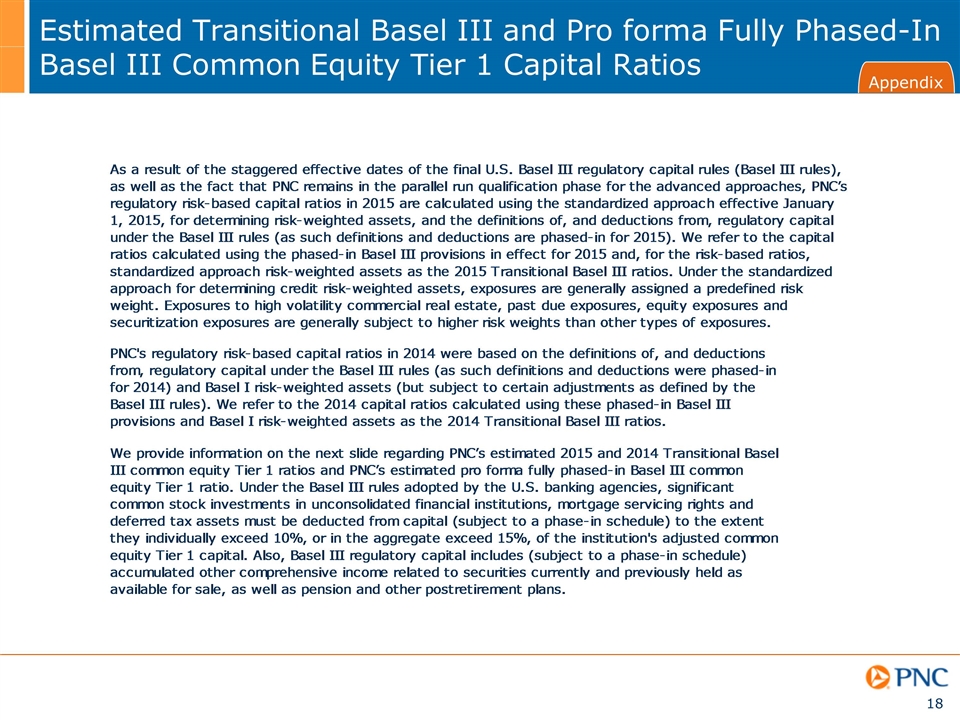
Estimated Transitional Basel III and Pro forma Fully Phased-In Basel III Common Equity Tier 1 Capital Ratios Appendix
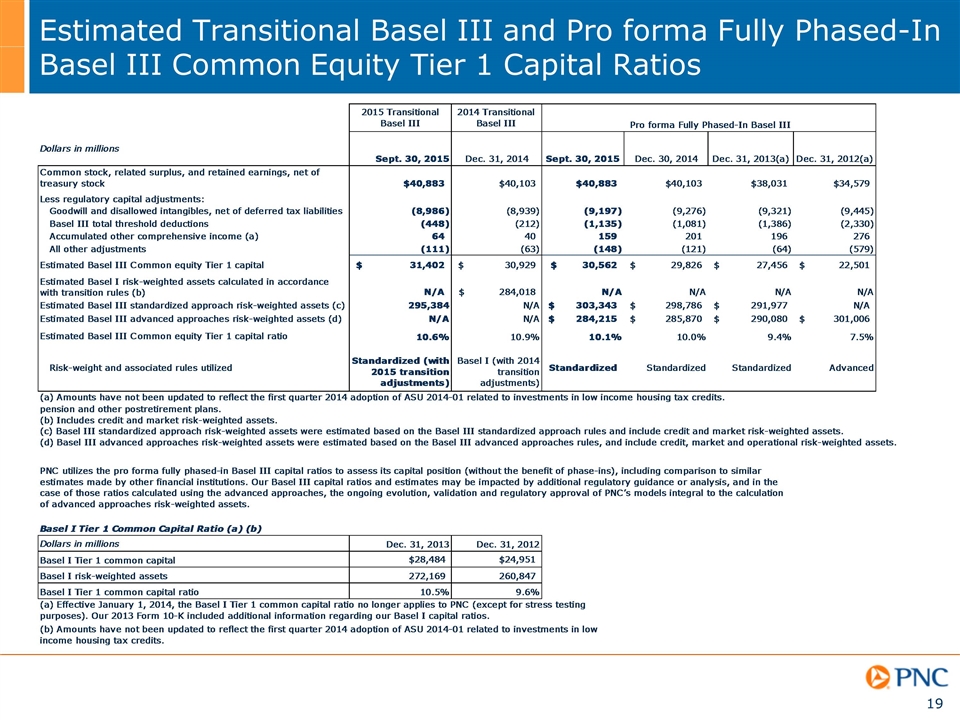
Estimated Transitional Basel III and Pro forma Fully Phased-In Basel III Common Equity Tier 1 Capital Ratios

Tangible Book Value per Common Share Appendix
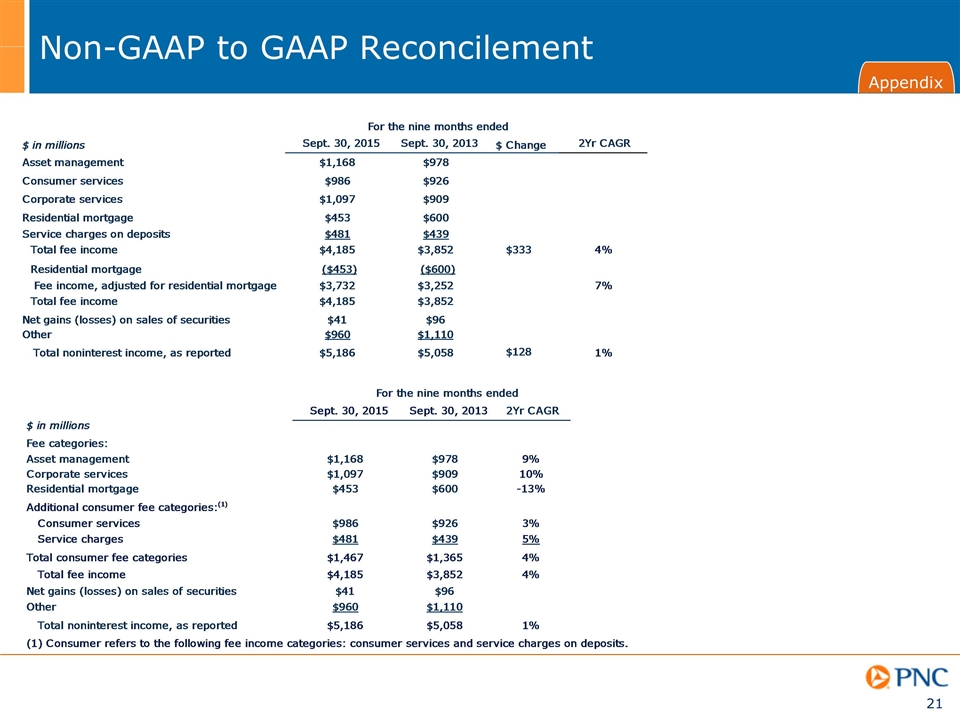
Non-GAAP to GAAP Reconcilement Appendix
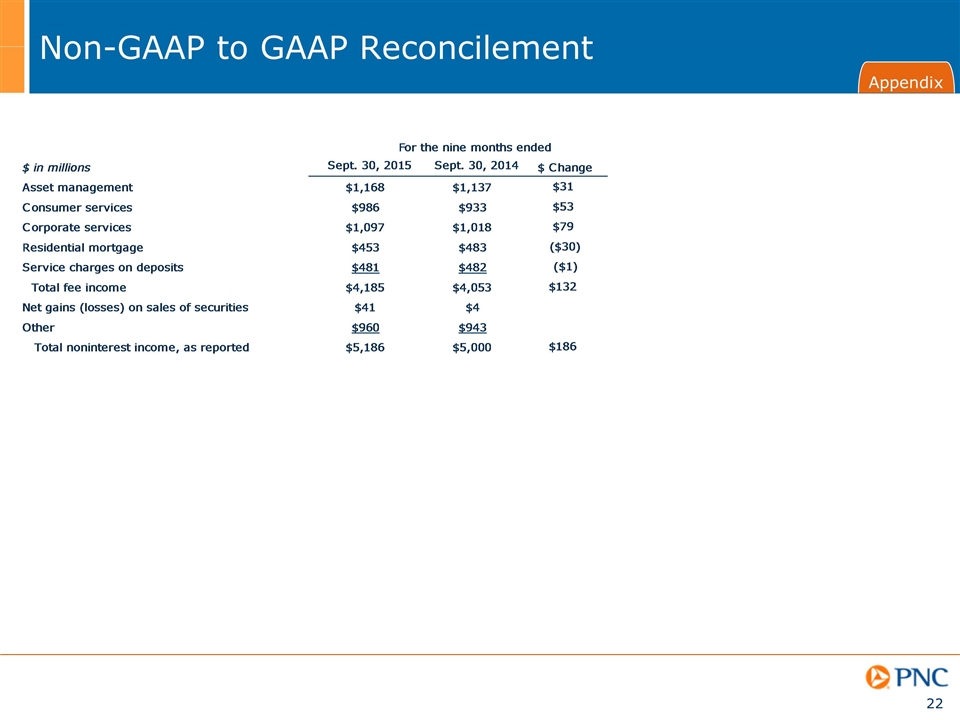
Non-GAAP to GAAP Reconcilement Appendix
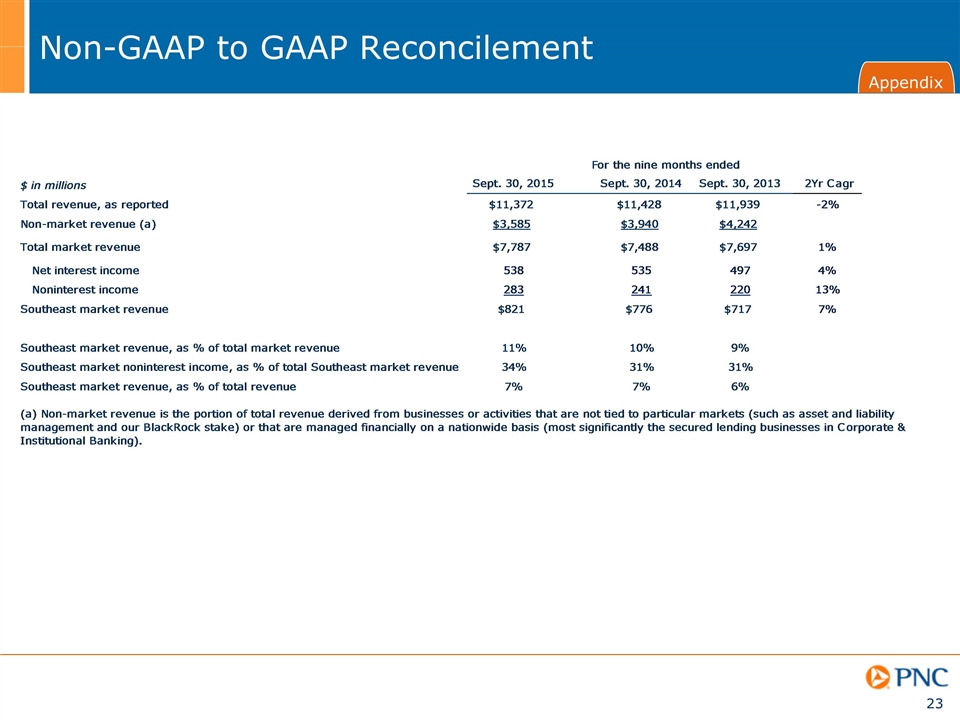
Non-GAAP to GAAP Reconcilement Appendix
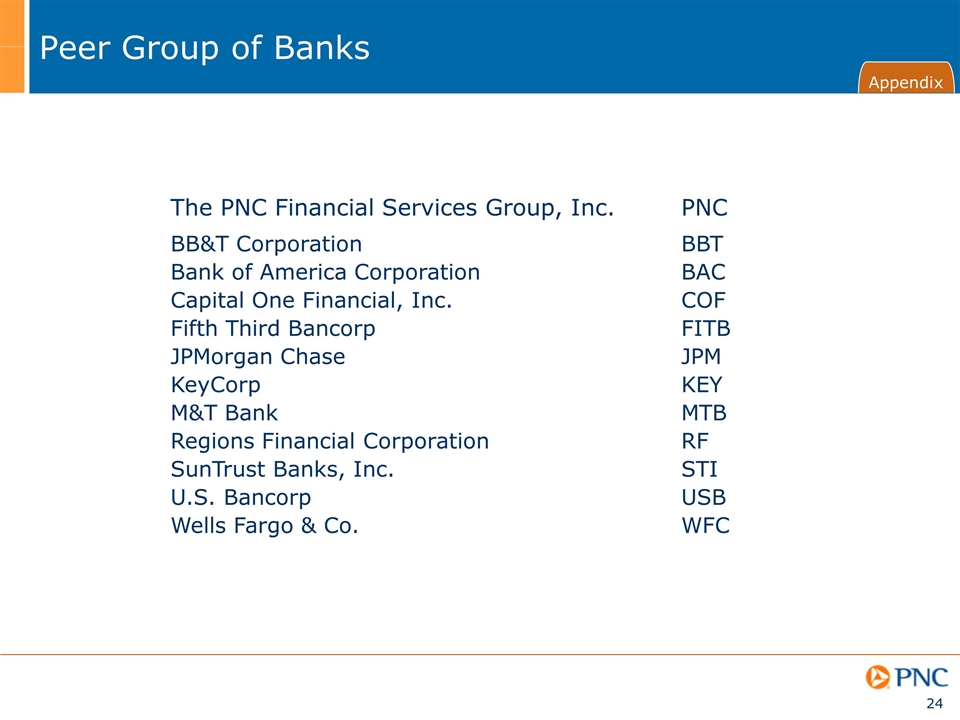
Peer Group of Banks Appendix The PNC Financial Services Group, Inc.PNC BB&T CorporationBBT Bank of America CorporationBAC Capital One Financial, Inc.COF Fifth Third BancorpFITB JPMorgan ChaseJPM KeyCorpKEY M&T BankMTB Regions Financial CorporationRF SunTrust Banks, Inc.STI U.S. BancorpUSB Wells Fargo & Co.WFC